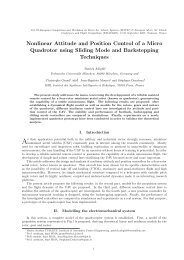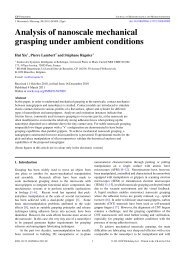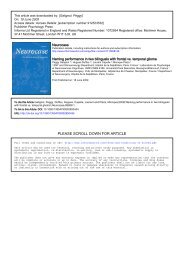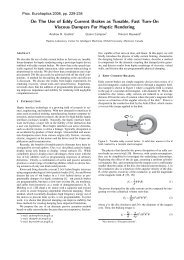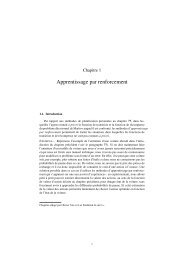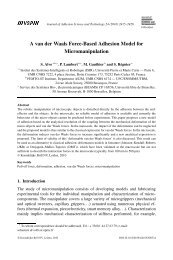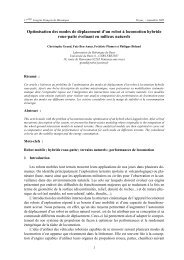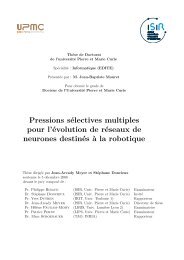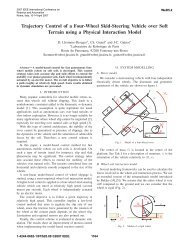The Pantograph Mk-II: A Haptic Instrument - CIM - McGill University
The Pantograph Mk-II: A Haptic Instrument - CIM - McGill University
The Pantograph Mk-II: A Haptic Instrument - CIM - McGill University
Create successful ePaper yourself
Turn your PDF publications into a flip-book with our unique Google optimized e-Paper software.
Proc. IROS 2005, IEEE/RSJ Int. Conf. Intelligent Robots and Systems, pp. 723-728.<br />
condition was created by lightly touching the interface plate<br />
while the response was measured. In the third condition, the<br />
device was loaded by pressing firmly on it.<br />
An ideal device should have a uniform gain across all<br />
frequencies (and would have to a SDR index of 1.0 [19]).<br />
Fig. 7 shows all three responses on the same graph but offset<br />
by 10 dB for clarity. <strong>The</strong> response was indeed flat over a wide<br />
bandwidth (40 to 300 Hz). But irregularities occured in the<br />
low and the high frequency regions.<br />
In the low frequency region, the rise in gain for the<br />
“unloaded response” was most probably due to presence of<br />
the rubber band and can be ignored. However contact with<br />
a finger creates a low Q resonance (Q factor 2 to 3) which<br />
shifted up in frequency when the finger pressed harder. This<br />
could be explained by the nonlinear nature of tissues. <strong>The</strong>se<br />
observations conspire to indicate that indeed, it would be<br />
difficult to reduce the finger to that of a linear time invariant<br />
system without risking to oversimplify the dynamics of the<br />
actual system [10], [18].<br />
In the high frequency region, there were two notable<br />
events in the response. <strong>The</strong> “unloaded response” first shows<br />
what is the typical fingerprint of a sharp, low-loss structural<br />
resonance (pole-zero pair) in the 400-500 Hz band. This could<br />
be attributed to flexibility inside the motor as these often<br />
emit acoustic noise at this frequency upon torque transients<br />
(this is also the case of all haptic interfaces using the same<br />
“bell coreless” motors). As the finger presses harder on the<br />
interface, this resonance is progressively masked by the load<br />
but probably continues to occur, but is unseen at the tip. Now,<br />
what is more difficult to explain are the additional events in<br />
the 900 Hz region, which instead of being attenuated by a<br />
larger load as one would expect, are actually enhanced to<br />
reach up to 30 dB of gain, a rather large magnitude indeed.<br />
If these were due to structural resonance of the linkages,<br />
then one would observe a shift in frequency due to nonlinear<br />
buckling. But it is not the case. This problem will be further<br />
discussed in Section V. In the meantime we established that<br />
the device can reliably be used in the DC–400 Hz range<br />
provided that proper roll-off filters are used [3].<br />
B. Resolution<br />
We estimated the actual device resolution using the setup<br />
shown in Fig. 8a. A micropositioner was connected to joint<br />
3 so it could back-drive the device along the y axis in the<br />
vicinity of point P iso . Backlash and other joint imperfections<br />
were likely to deteriorate the resolution of the device but<br />
should not be considered first. To minimize their influence, a<br />
constant torque was applied by the motor to preload the joints.<br />
Fig 8b shows the encoders values when the tip is moved<br />
by 50 µm. This verifies the resolution determined from the<br />
analysis of the Jacobian matrix.<br />
V. CONCLUSION AND DISCUSSION<br />
This paper has described the redesign of the <strong>Pantograph</strong><br />
haptic device with a view to increase its performance so it<br />
would be capable of providing high quality haptic rendering.<br />
Amplitude (dB)<br />
40<br />
30<br />
20<br />
10<br />
0<br />
Finger (press hard)<br />
Finger (press lightly)<br />
Loose rubber band<br />
40 100 400 1000<br />
Frequency (Hz)<br />
Fig. 7. Frequency Response of the device when an identical signal is sent<br />
to both the amplifiers to create an horizontal movement. <strong>The</strong> intensity of the<br />
movement is measured with an accelerometer approximately parallel to the<br />
movement. <strong>The</strong> response curves relative to the finger are shifted of +10 dB<br />
(light pressure) and +20 dB (hard pressure).<br />
a<br />
b<br />
0.006<br />
0.004<br />
0.002<br />
0.000<br />
-0.002<br />
-0.004<br />
-0.006<br />
Fig. 8. a) Setup used to verify resolution. b) Encoder reading during a linear<br />
movement of 50 µm. <strong>The</strong> plot shows that there are 5 or 6 ticks, matching<br />
the analysis made with the Jacobian.<br />
Its performance was evaluated and found to meet the initial<br />
expectations of uniform and wide bandwidth response. However,<br />
while the device operates very well, several points still<br />
need attention. <strong>The</strong> manner in which they can be addressed<br />
is now discussed by order of increasing implementation<br />
difficulty.<br />
1) <strong>The</strong> backlash in the joints in certain conditions, particularly<br />
when the plate is not statically loaded, can reach<br />
several encoders ticks. <strong>The</strong> cause was simple to find<br />
and so will be the solution to eliminate it. <strong>The</strong> present<br />
bearings were specified of ordinary quality. In fact, their<br />
backlash specifications match the observations. <strong>The</strong>y<br />
should be replaced by higher quality bearings since<br />
clearly this is a limiting factor.<br />
2) <strong>The</strong> device is machined out of aluminum. It is possible<br />
that the metallic structure participates in the observed<br />
unwanted high frequency resonance. Composite materials<br />
could be used to manufactured haptic devices with<br />
structural properties designed to optimize their response<br />
(e.g. adjust for critical damping) [17].



